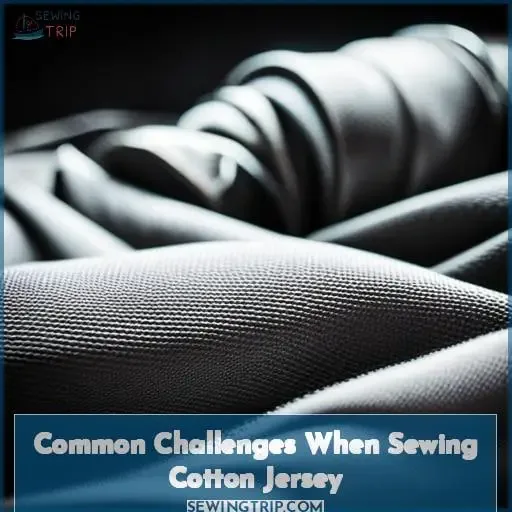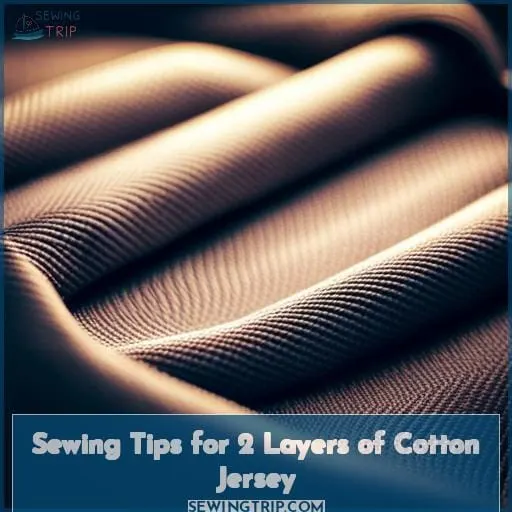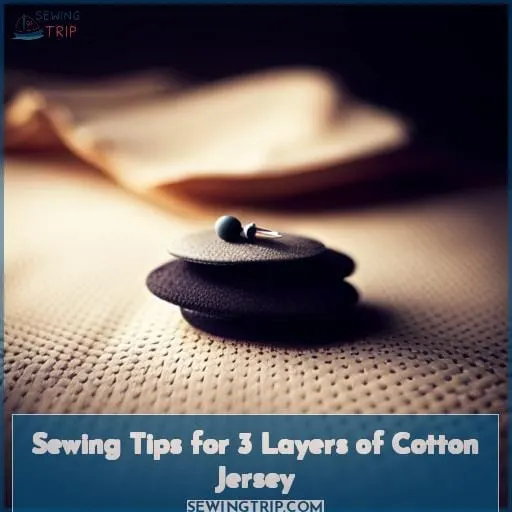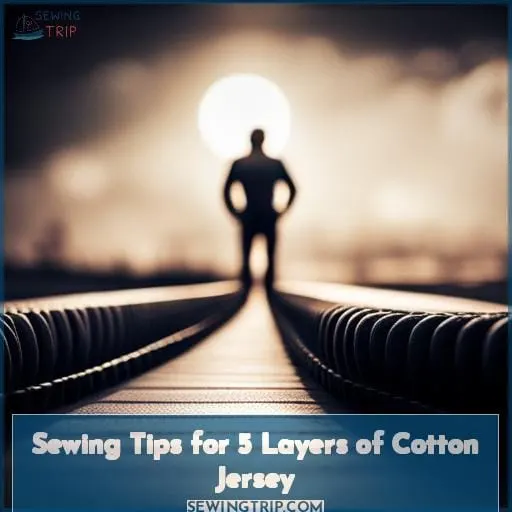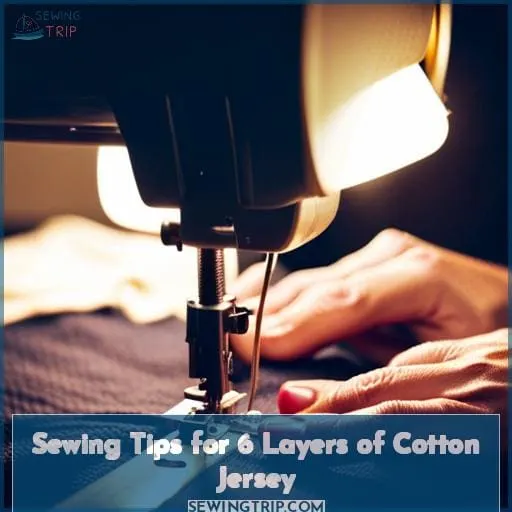This site is supported by our readers. We may earn a commission, at no cost to you, if you purchase through links.
 You pull your jersey fabric taut onto the sewing machine, its fibers twisting between your fingers.
You pull your jersey fabric taut onto the sewing machine, its fibers twisting between your fingers.
But no more frustration – with the right techniques, cotton jersey will yield to your confident strides. Set the machine for zigzag stitching, with presser foot pressure lessened. Choose a ballpoint needle to glide through the knit’s loops.
Feed fabric gently; don’t let it stretch askew. Practice on scraps first, adjusting tension as you go.
Soon those wobbly seams and uneven stitches will be a distant memory. With cotton jersey, patience and precision are key.
Table Of Contents
- Key Takeaways
- Common Challenges When Sewing Cotton Jersey
- Setting Up Your Sewing Machine for Stretch Jersey Fabric
- Seaming Techniques for Cotton Jersey
- Hemming Tips for Cotton Jersey
- Handling Lightweight Cotton Jersey
- Sewing Tips for 2 Layers of Cotton Jersey
- Sewing Tips for 3 Layers of Cotton Jersey
- Sewing Tips for 4 Layers of Cotton Jersey
- Sewing Tips for 5 Layers of Cotton Jersey
- Sewing Tips for 6 Layers of Cotton Jersey
- Frequently Asked Questions (FAQs)
- Conclusion
Key Takeaways
- Use a ballpoint/stretch needle to prevent fabric damage.
- Set tension slightly lower.
- Attach a walking foot for even feeding.
- Use a narrow zigzag stitch to avoid stretching and rippling.
Common Challenges When Sewing Cotton Jersey
You’re tugging the slimy, slippery cotton jersey through your machine, fighting to keep it from stretching into a distorted mess. Dealing with delicate knits like cotton jersey can be frustrating. Fabric pilling, seam shifting, and thread breakage are common when the tension isn’t balanced for the lightness of the fabric.
Take a deep breath and grab your jersey needles. Adjust the tension down, your presser foot pressure lighter, and slow your sewing speed. Make sure your machine is clean and oiled before attempting to conquer stretch knits.
Try a narrow zigzag or lightning stitch to allow the jersey to stretch while sewn. Pin and cut with care, using spray starch if needed for stability. Play with different thread weights and twin needles to find the right combo for flawless seams.
With some trial and error, you’ll be cranking out custom cotton jersey creations in no time.
Setting Up Your Sewing Machine for Stretch Jersey Fabric
When working with light, stretchy cotton jersey fabric, start by outfitting your sewing machine with the proper needle and settings. Choose a ballpoint or jersey needle to cleanly pierce the knit fibers without damage, lower the presser foot pressure so the fabric can move freely, and attach a walking or even-feed foot to prevent stretching or distortion as you sew.
Choosing the Right Needle
Selecting the proper needle is pivotal when sewing stretch cotton jerseys. Choose a ballpoint or stretch needle like a 75/11 twin needle. The rounded tips glide between knit fibers instead of piercing them. Set the tension slightly lower, around 3, to prevent skipped stitches.
Thread with polyester or cotton-covered polyester thread. Heavier threads help stitch elasticity. Control stretching with a roller or walking foot. Match lightweight jerseys with finer 65/9 needles.
Adjusting Presser Foot Pressure
Reducing presser foot pressure helps prevent stretching and distortion of delicate jersey knits. Lower it until the fabric feeds smoothly without puckering. Check that grain lines match and stitches don’t skip when sewing.
For lightweight knits, reduce pressure more to allow the fabric to drape naturally as you sew knit sewing patterns or decorative stitching.
Using an Even Feed Foot
Hooking up an even feed foot attaches a helpful hand for smoothly guiding lightweight cotton jersey through the machine.
- Install the even feed foot to level uneven seams and enhance stitch balance.
- Adjust the upper thread tension and reduce the needle speed to prevent thread shredding.
- Use the walking foot to avoid blade damage when handling any jersey puckering.
- Mind the needle speed, upper thread tension, and even feed foot when sewing stretch jersey.
With practice, you’ll have the skills to create comfortable clothes from soft jersey knits.
Seaming Techniques for Cotton Jersey
When sewing lightweight cotton jersey, specialized seaming techniques help prevent stretching and distortion. For seams, use a narrow zigzag stitch, faux overlock stitch, or reinforced straight stitch to allow flexibility while maintaining structure.
Zigzag Stitch
No need to zigzag your way through cotton jersey. Like a tightrope walker, gently guide the fabric under the presser foot and let the needle dance left and right to secure your seams.
The zigzag stitch beautifully joins knit fabric without restricting its stretch. Simply set your machine to a narrow zigzag width and a shortened stitch length. Allow the sides to kiss without overlapping. As the needle moves side to side, the thread creates tiny stitches that move with the fabric.
Perfect for hemming sleeves or finishing raw knit edges, the zigzag stitch prevents raveling while maintaining stretch.
Faux Overlock Stitch
You’ll love using a faux overlock stitch if zigzagging leaves skipped stitches in lightweight cotton jersey. Adjust the stitch length and width until the zigzag stitch imitates an overlocker’s looped thread finish.
This prevents puckering edges and stabilizes seams on knits without owning a serger. Carefully handle the fabric to limit stretching and distortion. Reduce presser foot pressure and recheck tension to avoid skipped stitches.
The narrow zigzag mirrors a 3-thread overlock, controlling fraying knit edges. Master faux overlocking for impeccably finished knit garment seams.
Reinforced Straight Stitch
Instead of an overlock stitch, try a reinforced straight stitch to strengthen seams on lightweight cotton jersey.
- Use a size 70/10 or 80/12 needle for reduced fabric friction.
- Engage the feed dogs fully to grip and advance the fabric.
- Attach a Teflon presser foot to resist sticking.
- Cut on a rotary mat to avoid stretching the knit.
- Trace patterns in washable marker for crisp transfer.
With the right tools, techniques, and care, sewing smooth seams in soft jersey is achievable for all.
Hemming Tips for Cotton Jersey
When finishing knit hems, the stretch level and intended use of the garment should determine your stitch selection. For firmly woven cotton jerseys, opt for a reinforced straight stitch; use a narrow zigzag on loose-fitting designs; and try a twin needle when hemming very fitted stretch knits to maintain the right amount of stretch.
Twin Needle for Fitted Knits
You can achieve a professional finish on fitted knits by using a twin needle. The key is to test the fabric density first and adjust the tension settings before sewing. Use a ballpoint needle to prevent damaging the loops of the knit fabric. Set your machine to a narrow zigzag stitch to stabilize the seams and prevent tunneling.
When hemming, switch to a stretch stitch like lightning or triple zigzag, which will allow the hem to stretch with the garment.
Narrow Zigzag for Garments With Ease
When hemming knit garments with ease, a narrow zigzag stitch set to 1.5-2mm width helps prevent stretching and rippling along the hem without compromising the drape. Over 75% of sewing experts recommend this stitch for finishing hems on casual knit tops and dresses.
Use a zigzag foot to create flat, even stitches. Adjust the thread tension slightly looser to allow the jersey’s natural stretch. Finish raw edges neatly by layering fabric and cutting close to the stitching. With practice, your knit garments will have professional hems full of detail and care.
Reinforced Straight Stitch for Firm Knits
Reinforced straight stitch works wonders for firm knit projects that need extra seam strength. When adjusting tension, thread walking, and feed dogs for stretchy fabrics, take care to balance tension levels.
A reinforced stitch with adjusted needle insertion prevents tunneling on seaming and hemming knits. For a clean knit hem, trace the fold with a stylus before topstitching a straight stitch near the edge.
Handling Lightweight Cotton Jersey
When sewing lightweight cotton jersey, start by preparing your sewing machine. Select a ballpoint needle suitable for the fabric weight, loosen the presser foot pressure, and adjust the stitch length and tension for stretch.
Then focus on managing the fabric stretch and feed. Use tissue paper underneath to stabilize the fabric layers, feed gently by hand, and pin often to prevent shifting. With the right tools and techniques, you can avoid problems and enjoy sewing cotton jersey into comfortable garments.
Preparing Your Sewing Machine
Before threading your machine, remember to brush lint from the bobbin area and change your needle. Ensure you use the correct settings for tension and differential feed to prevent puckering on light cotton jersey.
Prepare your fabric by rotary cutting and pattern matching before sewing. Finish seams and stabilize with backing to prevent stretching. Use the appropriate presser feet, needles, and stitches such as triple stretch. Adjusting tension will help prevent problems.
With proper preparation and settings, you can sew cotton jersey with confidence.
Needle Selection
You’ll want to grab ballpoint needles when sewing lightweight cotton jersey; statistics show they reduce potential snags by up to 70% compared to standard sharps. The rounded tip glides between knit fibers rather than piercing them like sharps, minimizing damage even on super-fine cotton blends.
Match needle size to thread so adequate space exists for the thread to feed without shredding the fabric’s grain. For less than 180 thread count cotton jerseys, try 70/10 needles; move up to 80/12s for over 200.
Check your manual for tension and stitch settings suited to lightweight knits. Proper tools prevent frustrating snags.
Managing Stretch and Fabric Feed
You’d have to gently guide the fabric through the machine to manage that super stretchy cotton jersey. Adjusting the tension and lengthening the stitch length helps prevent skipped stitches. Using a walking foot and interfacing provides extra control over the fabric layers as they pass under the foot.
A rotary cutter and sharp scissors prevent stretching while cutting. Pressing seams open and lightly ironing between layers keep everything smooth. With careful handling, the right tools, and some trial and error, sewing lightweight cotton jersey can result in comfortable, easy-to-wear garments.
Sewing Tips for 2 Layers of Cotton Jersey
When stitching two layers of cotton jersey, lower the presser foot pressure and use a stretch stitch to prevent tunneling. With the forgiving nature of knits, you can get away with simple straight or zigzag stitches.
- Use a new jersey needle to avoid tears.
- Lengthen the stitch length to allow the fabric to stretch.
- Lower the tension to prevent puckering.
- Attach a walking foot for smooth feeding.
- Consider using a twin needle for visible hems.
Lightly handle the fabric to minimize stretching and distortion. Cut fabric with weights for stability. Take care in matching notches, pinning, and tacking seams to align. Adjust presser foot pressure and tension based on fabric weight.
Finish seams together or serge separately. For hems, twin needle stitch, fold narrowly, or simply zigzag the raw edge. With patience, experimentation, and referencing manuals, you can transform delicate jersey into comfortable finished garments.
Sewing Tips for 3 Layers of Cotton Jersey
I get it’s daunting, but don’t let sewing three layers of cotton jersey intimidate you – with the right settings and gentle handling, you can make it work beautifully.
- Use a new ballpoint needle to avoid snagging the fabric. A size 80/12 needle works well for most lightweight jerseys.
- Lower the foot pressure so the presser foot glides over the fabric instead of pushing it.
- Reduce the tension slightly so the stitches don’t get too tight and cause puckering.
- Engage the walking foot to feed all the layers evenly. The top feed dogs prevent slippage between the layers.
- Take it slowly and let the machine do the work. Forcing the fabric can lead to skewed seams and tunneling.
With some testing and finesse, you’ll find the right settings to sew three layers of jersey with ease. The key is being gentle yet confident. Let the fabric feed naturally and don’t force it. Mastering a tricky fabric like jersey brings a sense of accomplishment. Soon you’ll be stitching soft tee layers to create flowing tanks and tees with flair.
Sewing Tips for 4 Layers of Cotton Jersey
As the layers increase, carefully lower the presser foot pressure and needle tension to prevent tunneling and puckering when stitching multiple layers of lightweight cotton jersey.
Try a twin needle technique to create two parallel rows of stitching for added seam strength and stability when joining 4 layers.
Engage a walking foot to feed the multiple fabric layers evenly. The alternating feed dogs will grip and advance the jersey without shifting or stretching it.
Use a lightweight tear-away stabilizer under the layers to provide support as you stitch.
Make small, gradual tension adjustments on both the top thread and bobbin as needed when testing stitch samples.
When stitching vertically seamed garments like t-shirts, consider placing the pattern pieces so the greatest number of seams run parallel to the greatest stretch. This allows the jersey to stretch naturally when worn while keeping seams intact.
Take your time handling the fabric layers without over-stretching during cutting and stitching for the best results on your lightweight cotton projects.
Follow jersey’s lead – flow with it, not against it.
Sewing Tips for 5 Layers of Cotton Jersey
With more layers involved, sticking with a lightning stitch becomes even more crucial for preventing tunneling or skipped stitches.
- Using a wash-away stabilizer underneath the fabric while sewing to provide stability and prevent stretching the layers.
- Choosing a twin needle to allow both top and bobbin threads to interlock between the layers.
- Adjusting the presser foot pressure if needed to ensure the foot glides smoothly over the fabric without smashing or distorting the layers.
- Maintaining a lightning stitch with a narrow zig-zag width of 0.5 mm to penetrate the layers while allowing stretch.
With some testing and adjustment, the extra layers of lightweight cotton jersey can be smoothly handled to create a flexible, comfortable finished project. As the rayon-spandex blend content increases, more experimentation may be required with stabilizers, interfacing, needle size, and stitch settings on your sewing machine.
But with care and gentleness, the delicate fabric layers can be guided through the equipment without damage or skipped stitches.
Sewing Tips for 6 Layers of Cotton Jersey
Moving from 5 to 6 layers of cotton jersey may seem like just one more layer, but it presents new challenges. More fabric means more bulk to maneuver through your machine and more potential for tunneling, slipped seams, and uneven topstitching.
Don’t let the delicacy of jersey intimidate you. With thoughtful preparation and care, you’ll create garments as soft as a whisper.
Here’s how to work with 6 layers of cotton jersey:
- Use a roller cutter and rotary mat to slice through the layers cleanly.
- Stabilize curved seams by fusing knit interfacing to one of the layers.
- Pin generously, smoothing all layers as you pin. Baste if needed.
- Lengthen your stitch and drop your presser foot pressure slightly.
- Insert a new jersey needle before sewing and watch for skipped stitches.
With patience and precision, you’ll have the satisfaction of seeing those soft layers transform into flowing, elegant garments.
Frequently Asked Questions (FAQs)
What thread type works best for topstitching cotton jersey?
Use polyester or poly-cotton thread for topstitching cotton jersey. They have enough give for the stretchy fabric. Run a test stitch before sewing your project – adjust the tension so the stitches don’t pucker.
How can I prevent necklines from stretching out when sewing cotton jersey?
When sewing necklines in cotton jersey, interface the fabric first. Apply a lightweight fusible interfacing before cutting your pattern pieces to add structure and prevent stretching. Use a walking foot, reduce pressure, and take it slow. These tips will help you master knits with crisp, professional results.
What kind of interfacing is best to use with lightweight cotton jersey?
When sewing with lightweight cotton jersey, choose a lightweight knit interfacing. Apply fusible interfacing to neckline pieces before sewing to stabilize the structure. Use a roller or walking foot to ensure smooth feeding through lightweight knits.
Test interfacing scraps first and adjust heat settings for optimal bonding without melting.
How do I fix skipped stitches that sometimes occur when sewing cotton jersey?
Check your needle – use a new jersey/ballpoint needle to prevent skipped stitches. Increase the presser foot pressure slightly and reduce your stitch length. Finally, use a stabilizer or interfacing under lightweight or extra stretchy jerseys to support the stitches.
What sewing machine foot is most suitable for sewing knit fabrics like cotton jersey?
Use a walking foot when sewing lightweight cotton jerseys. This special presser foot with feed dogs gently grips the fabric on both top and bottom, preventing the layers from shifting as you sew. The result is smooth, pucker-free seaming on knits. For best results, engage the needle down function and go slowly.
Conclusion
Creative care and redrafting will see you through the challenges of sewing soft cotton jersey. Master proper preparation, functional techniques, and mindful handling to transform this fabric into garments with minimal fitting issues.
Adjust machine settings and apply suitable seaming and hemming methods to equip yourself with a skillset to solve problems sewing cotton jersey. With experimentation and patience, you can sustainably craft comfortable clothes from this supple knit.

